UG Thesis 2023 Showcases Expansive Cultural and Architectural Exploration
On Saturday, April 22, SCI-Arc’s halls were freshly abuzz once again with this year’s Undergraduate Thesis reviews. With each of the school’s display spaces brimming with the elaborate and stunning models for which SCI-Arc has become renowned, graduating B.Arch students presented and defended the final thesis projects they’d spent the entire past year ideating, developing, and building.
Each year, UG Thesis at SCI-Arc represents the culmination of the five-year B.Arch curriculum, which challenges the next generation of architects and designers to take a dedicated architectural position in the form of a highly-developed building project. During their final year in the B.Arch program, graduating students are required to propose solutions for eminent issues in architecture, a pedagogical model that empowers students to move between speculative frameworks and the tangible considerations built architecture confronts.
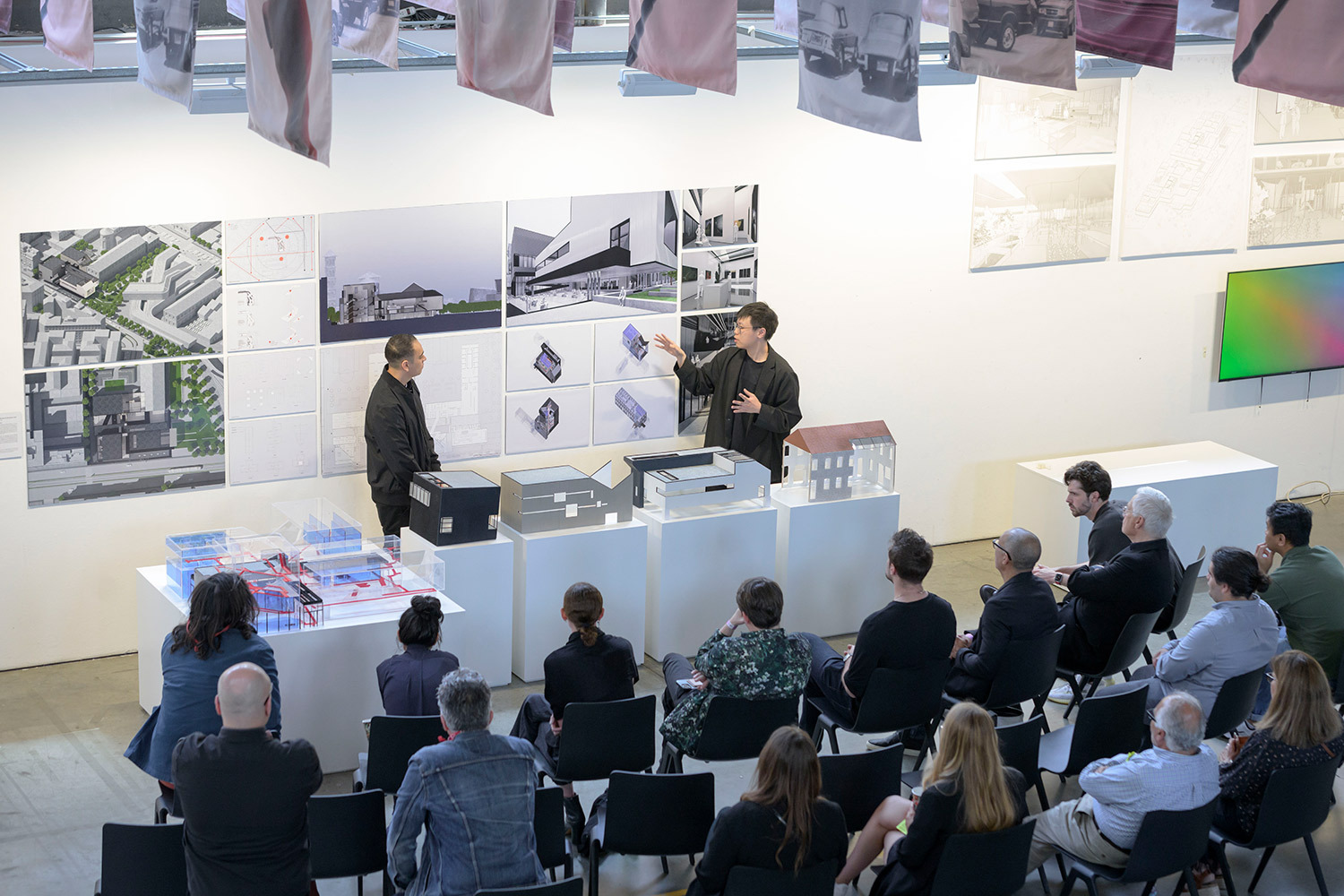
Presentations on view included dozens of projects which incorporated Brutalism, monumentality, neurodiversity, collections, and more. Several noteworthy theses and their descriptions are featured below.
“Thesis offers students both endings and beginning,” reflected Undergraduate Thesis Coordinator Maxi Spina. “What students interrogated through their projects this year also represented a cross section of the cultural moment—from the design of architecture for the neurodiverse to the waste remediation of buildings to the idea of campuses as sites of democratic and experimental pedagogy.
“Presented across formats, from images, material, both visual and performative, this year’s thesis projects highlighted architecture’s efforts to deepen its agency and entanglement with contemporary issues,” he shared.
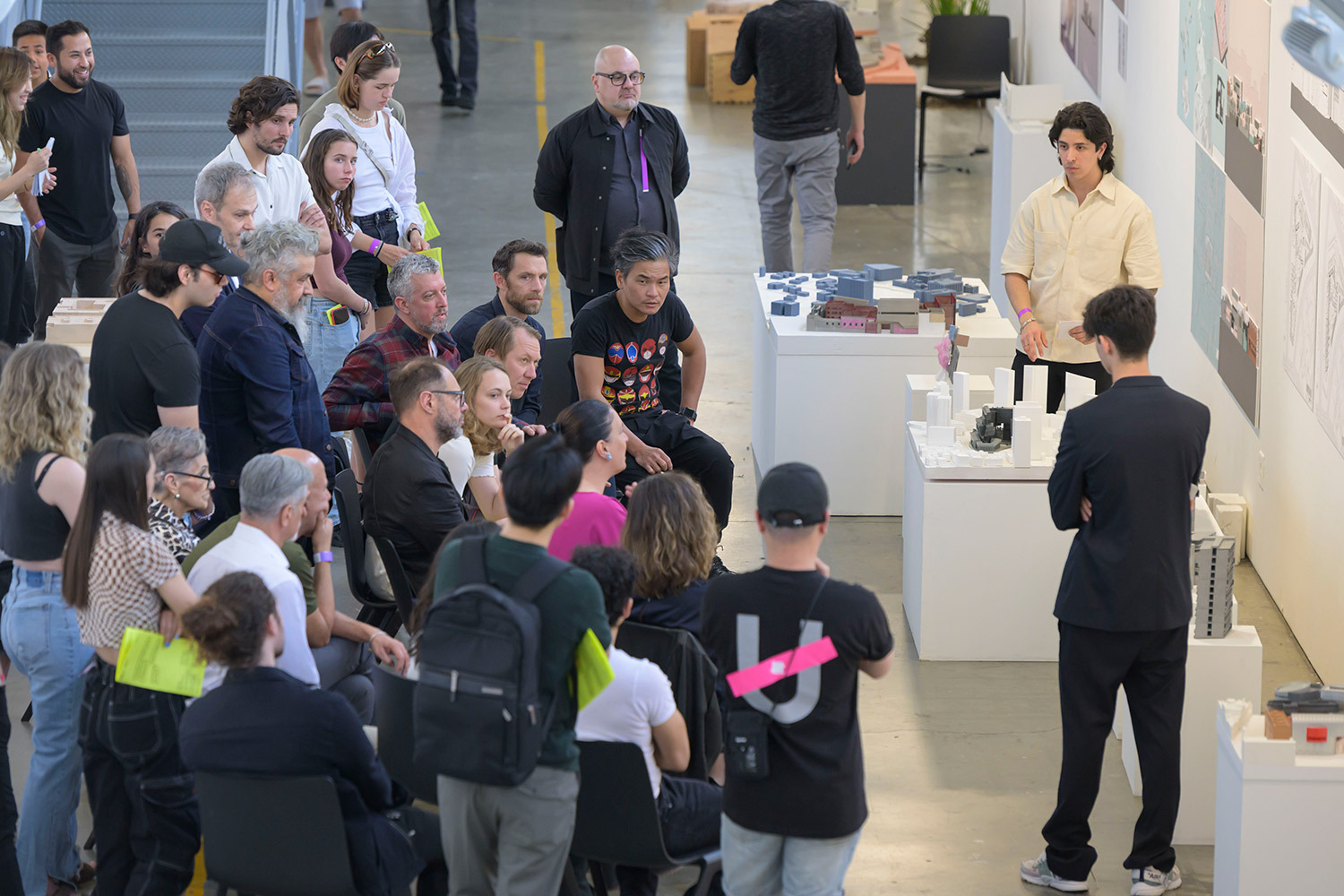
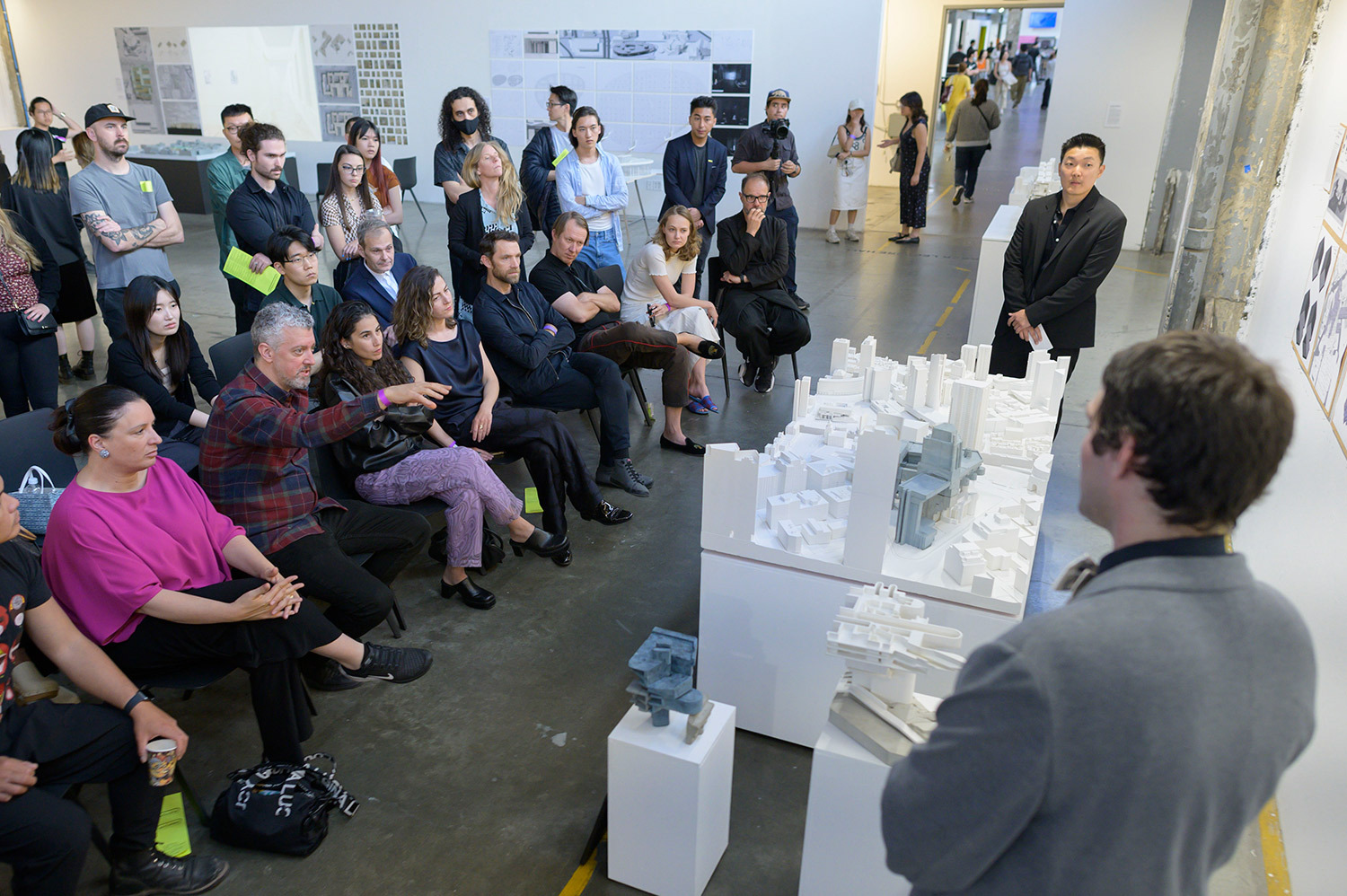
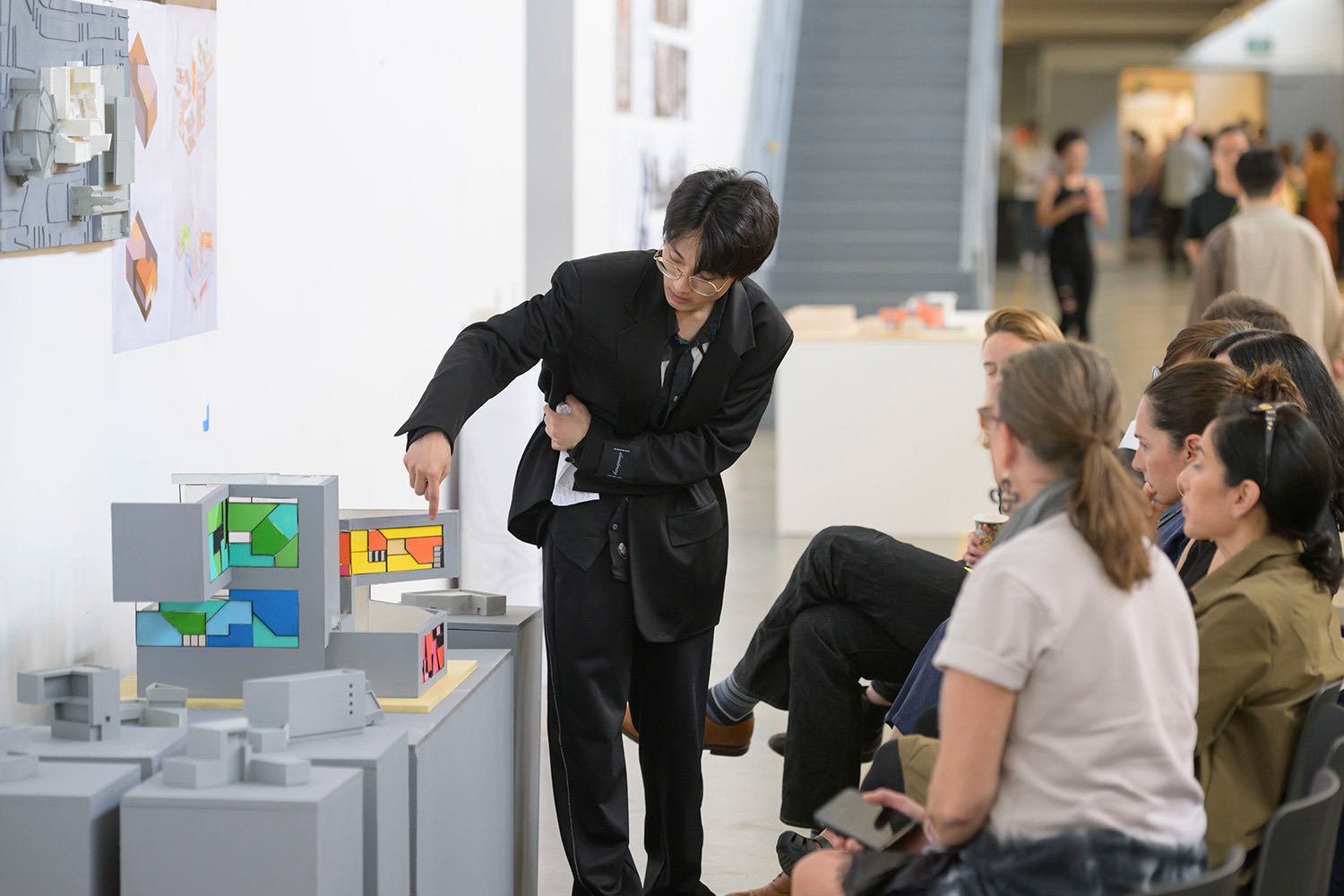
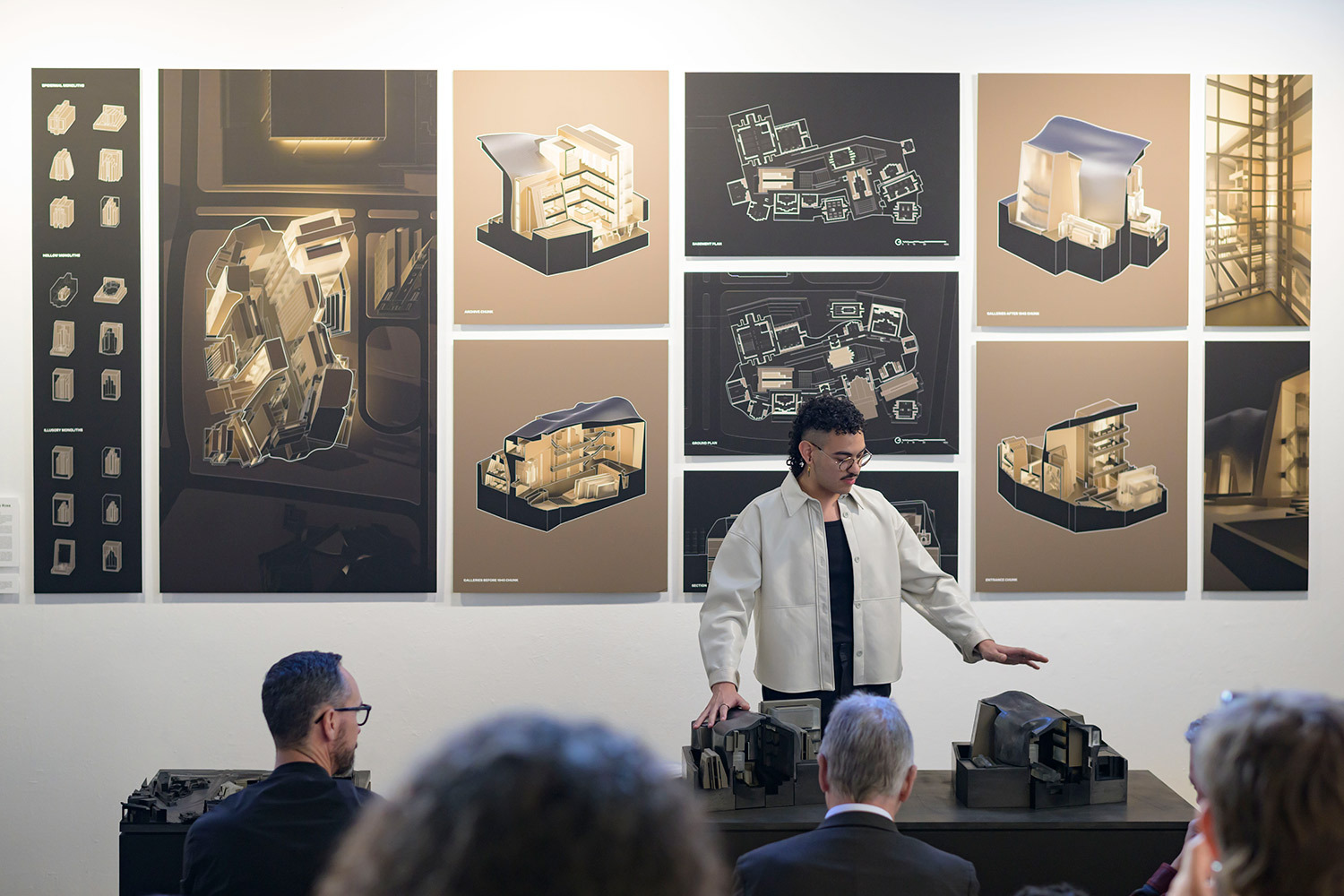
One presenter Santiago Sanchez, reflected of his thesis with fellow student Francisco Valdez, noting that “[our] work and our interest was based around the idea of embracing monumentality and in adapting tectonic Brutalist features for more contemporary standard architecture and its discourse.”
For Eric Swanson, the event held particular significance surrounding moving out of their academic career and into the world of architecture practice. “My thesis is called ‘Collections,’” he shared. “It's an exploration of architectural collections and how we experience them in a fragmented way and combine them by piecing together maps of the city in our own minds.”
In reflecting what his experience of studying architecture has meant to him over the past five years, he said, “SCI-Arc's my home. I love this place. I'm going to really miss it.”
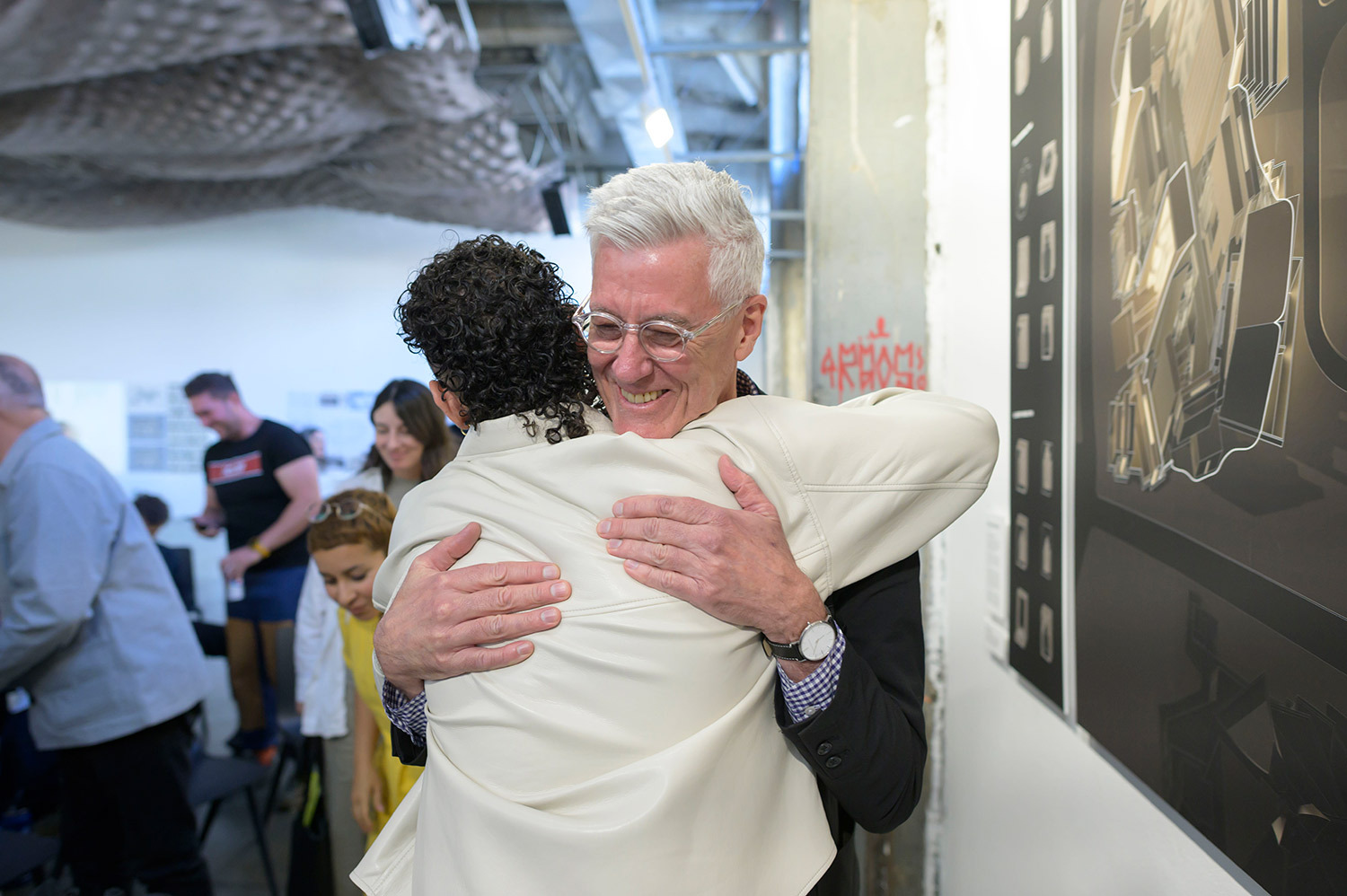
Marcelyn Gow, SCI-Arc’s Undergraduate Programs Chair commented on the value of the uniqueness and diversity of perspectives often expressed during Undergraduate Thesis, as “a moment where students show us what the world should look like and how architecture can change the world.”
Richard Mapes (M.Arch ’21), teaching fellow and assistant teacher at SCI-Arc, spoke about thesis as a launching pad for students. “It's a place where students, can explore ideas that are valuable to them, and mature those ideas over the course of a semester or a summer, in a way that can prepare them to engage, in a myriad of different forms of practices when they leave SCI-Arc.”
“The students at SCI-Arc are brave,” he continued. “They are innovative and ingenious, but above all they explore ideas that are on the fringe of our consciousness and making new worlds in real time while they are here.”
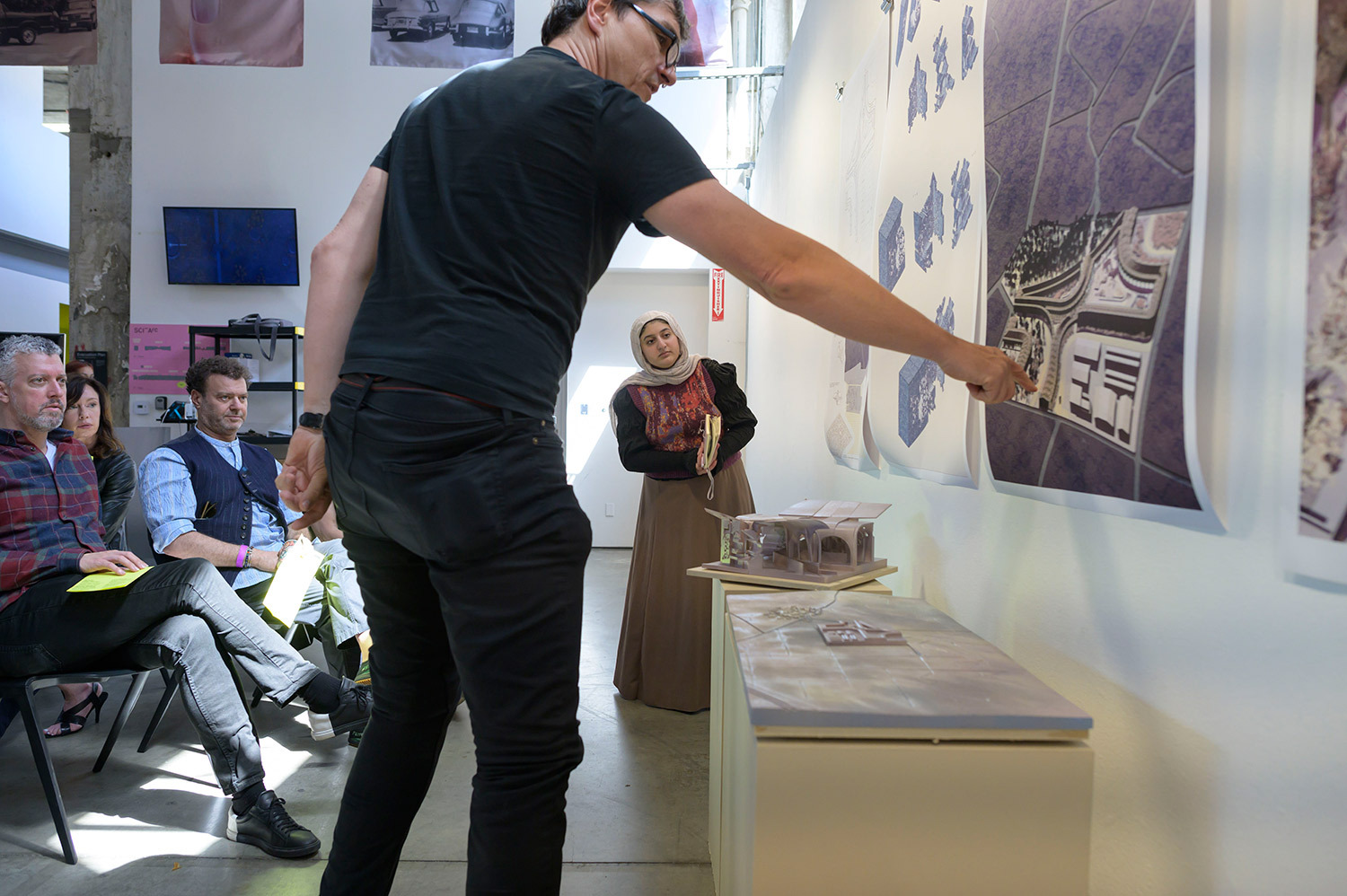
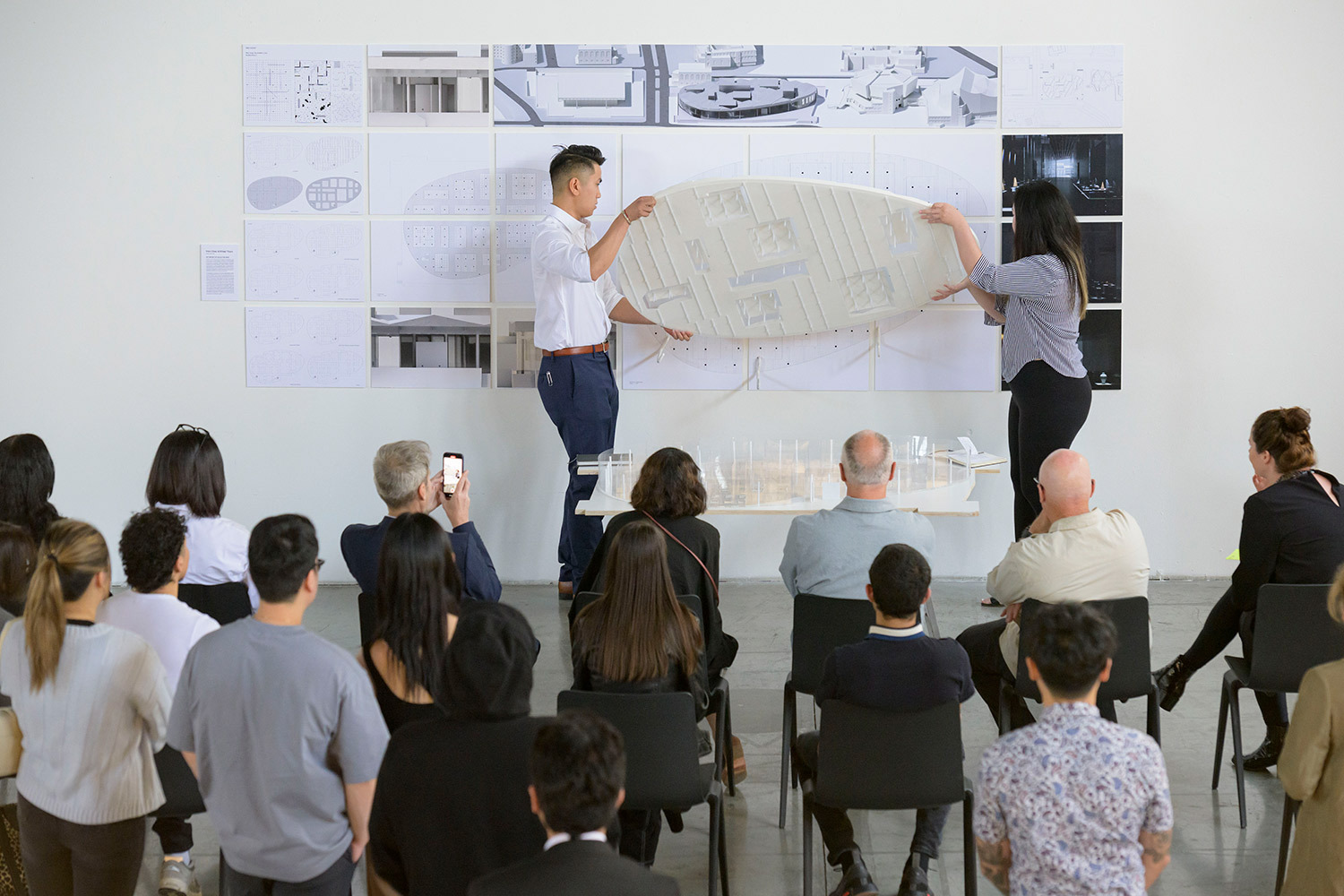
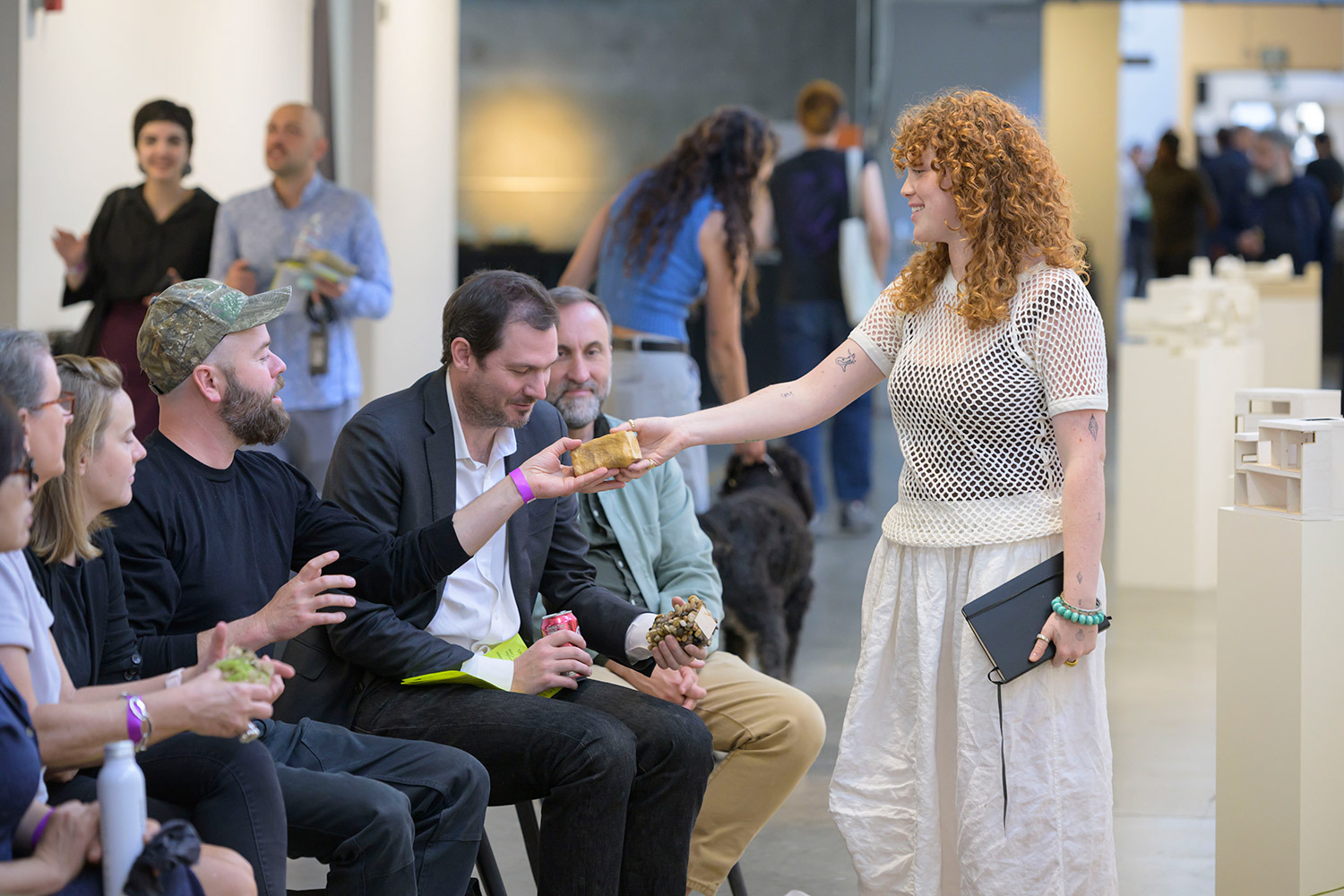
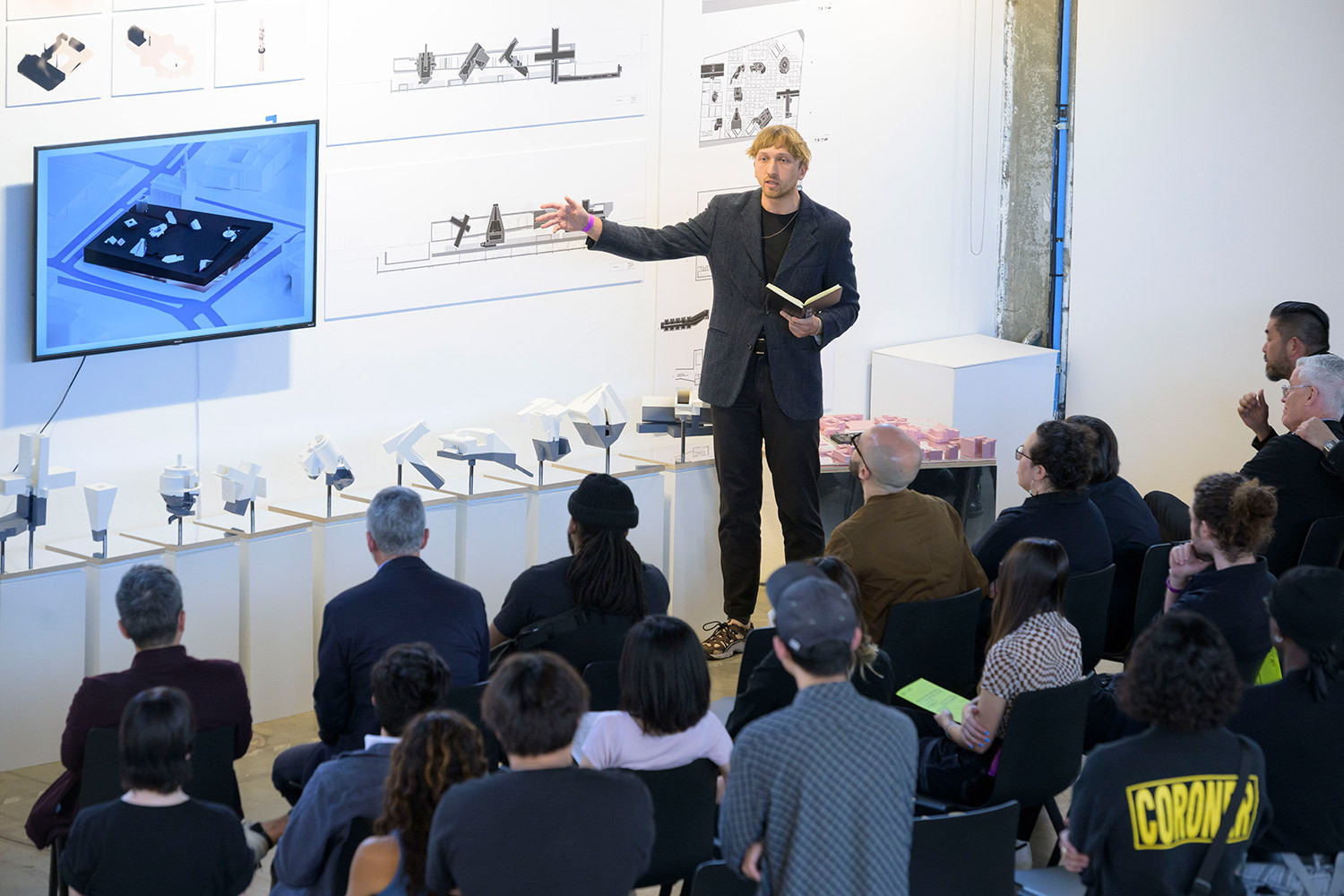
Nandini Parekh
Motion Sequence
Advisor: Maxi Spina
This is a project of curating movement within a space by reconfiguring the typological diagram of circulation networks. Using the Museum of the 20th C as a host, the project looks to create a renewed sense of experiencing art and reconceptualizes the way in which we situate ourselves in space.
Circulation spaces are the kinetic volumes that connect the inert programmatic spaces and serve themselves to this movement. The idea of reconfiguration of circulation networks is to blur the boundary between Kinetic and Inert spaces and transform the networks to become both the transitional element as well as programmatic space. The thesis began with cataloging the conditions that allow moving up and across space through typological diagrams of ramp and stairs like straight run, L-shaped, U-shaped, curved and spiral which were put through design transformations to create reconfigured models of movement.
These kinetic spaces are visualized as sloping ground, folding planes, program element, exterior and facade element. The volumetric hybrid assets created by using these new diagrams are deployed over the site. Many art museums are characterized by strict divisions between exhibition spaces and reading rooms, between collection and archive, between art and non-art. The thesis, by contrast, looks to closely intertwine the immediate art experience and the in-depth exploration of art and create an overall loss of individual identity of spaces. The Museum of the 20th C in Berlin then becomes a project that can successfully host this exploration of circulatory transformation and look to create a fluid movement focused on individual modes of perception and actively shaping the experience of the user.
Ethan Tham + Yoko Chan
Between the Egg and the Grid
Advisor: Maxi Spina
This thesis is focused on the utilization of repetition in the formal design and internal field conditions. This encompasses the repetition of simple geometries as well as the internal elements used for the program. These may also appear in structural conditions and spatial aspects. A dense display of repetition has the ability to create a relentless linear or gridded pattern that forms an almost overwhelming space, perhaps reaching a phenomenological sense. Furthermore, the continuity of interior and exterior repetition can enable individuals to experience a holistically relentless and immersive experience. The use of repetition in formal and organizational design not only enhances the structural grid, but also a building's functionality, legibility, rhythm, and flow.
Therefore, repetition can create a sense of unity and coherence, giving the building a strong visual identity within a culturally historic site—Kulturforum in Berlin. The nature of the egg-shaped form also creates an endless circulation that continuously brings the visitor back into the project's grid, just as one experiences in the Kulturforum.
Additionally, repetition can be used to create a rhythm that can guide the viewer's eye from the exterior to the interior, highlighting important elements and creating a flow of movement. As such, we are continually fascinated by the potential of this design strategy, while exploring the limits and interruptions of repetition and its ability to push the boundaries of architectural design.
Esly Hernandez
Impinging Space
Advisor: Karel Klein
Different voids and broken pieces within massing’s are considered left over fragments and in my case, I am exploring a way to utilize these remaining fragments of space to explore both complimentary interior and outdoor urban conditions. While looking at ways to intersect various programs, I am focusing on a few techniques to create unexpected spatial conditions allowing circulation to flow through and around the building by creating a sense of unified spaces while at the same time giving visitors freedom to either follow paths clearly defined by the architecture or skip from room to room in a nonlinear fashion.
The Maxxi Museum Extension utilizes an obscured site which will challenge my idea of breaking up the program and use the leftover space to neutralize differentiation between private and public space. By allowing the buildings program to unfold as a spatial experience, circulation becomes responsive by the removal and replacement of long hallways or corridors while challenging the program by linking the relationship between collaborative space within the new research addition to the Maxxi Museum.
Eric Swanson
Collections
Advisor: Russell Thomsen
My thesis asks how architecture operates as a collection. Collections take many forms, from scientific archives (periodic table of elements, garment design archives) or as a work of curation set to describe an idea greater than the sum of its parts (an art exhibition). While the artifacts of a collection exist as objects unto themselves (re-contextualized by the act of collection), the observer brings their own viewpoint formed a priori to any encounter with them. This is much like the experience of the city whereby we internally map its volumes and facades based on individual experience, interest, and chance. As we never have a complete understanding of a city, we never have a complete understanding of a collection, we never experience it exhaustively or as instructed. As such, we less consume an intended narrative than we engage in a dynamic, incomplete dialogue with the contents of a collection, to shape a narrative among a possible many.
The extension project for the Neue Nationalgalerie in Berlin seeks to explore the nature of collections; a collection of artworks, a collection of discrete experiences within a new ground, a collection of post-war buildings from the cultural forum of a city recovering from its Fascist past, an involuntary collection buildings and former buildings, places and events that describe Berlin. A new ground occupies the void of the recent past, a collection of discrete building volumes occupies that ground, each never completely understood from a single vantage point. The museum will always be an incomplete experience, obliging each of it’s visitors to (re)construct a whole from the fragmentary, episodic understanding of its parts. As a collection it enables an ethos; it resists cohering to a single, pre-determined entity or narrative. It remains unstable and slippery, sublimating itself to the user.
Ji In Jeong + Jennifer Frangieh
Go-Between
Advisor: Russell Thomsen
“A space is something that has been spaced or made room for, something that is cleared and free, namely within a boundary … A boundary is not that at which something stops but...the boundary is that from which something begins its presencing.”
—Martin Heidegger, Building Dwelling Thinking
Boundaries take many forms, from clear borders that intentionally underscore difference to maintain separation, to overlapping zones that instead seek to enable what is shared. To thicken a boundary is to transform a line into a volume, an in-between that belongs to not one or another, but both. The architecture of this boundary is volumetric, spatial, and fuzzy. Like a three-dimensional Venn diagram, it represents a third thing that emerges when two different conditions meet.
The Abrahamic Family House is an optimistic, religious institution that seeks to emphasize what three different religions (Islam, Judaism and Christianity) have in common as well as to acknowledge their differences. Without defaulting to an erasure of difference, this project seeks to construct the architectural conditions that allow both to co-exist in a single building as a place of exchange. It explores boundaries without antagonism, animated by an awareness of the other.
Rudain Almulla
Notes on Excess: Meandering, Cloistering, and Then Some
Advisor: Karel Klein
The thesis investigates George Bataille’s economic theory of ‘the accursed share’, which is the non-recuperable excess of energy that is ever present in all economies, ultimately destined for waste. That when it comes to energy, the sun gives, and gives, and gives. This continual outpouring means that there will be an inevitable overflow of waste. The manner in which a society chooses to use up this waste defines its characteristics. Culture is cultivated by excess. Festivals, art, architecture. All inefficient, without gain. My thesis investigates a harnessing of this waste through an embrace of excess in architecture.
Excess of circulation, ornament, wandering colonnades, odd aperture, alcoves, nooks, niches, winding gardens, and cloistered courtyards.
The project, located in Gyeongsangbuk-do, rural South Korea is an agricultural resources center. Unlike the vast expanses of farming fields surrounding the site, the institution here is not driven by efficiency, but in research, experimentation, and education. My proposal expands on this idea and forms a project that is meandering in its form, not interested in conforming to an architecture that facilitates a streamlined mode of work. The research center winds itself up, almost serpentine in its shape. A direct dialogue between the building and the site is created, carving out cloistered gardens. The form that the courtyards take up seemingly take priority, the meandering building happy to comply.
Attached to the winding building are arcades that house a museum program for visitors and inhabitants of the building alike. The museum attaches itself onto the meandering form via a system of modular blocks. The blocks are an embrace of ornament, excessive in their intricacy. Pulling from ornate middle eastern carpets, an instance of both magnificent waste and sacred excess. Moments from the carpets’ lush foliage are sampled, figures and silhouettes are lifted. From the ornament of the carpet comes ornament anew. When the modules entangle into each other, they create nooks, alcoves, and the sort - inhabitable space, once again.
The inhibitor is encouraged to wander, to stroll, to slow down, to take routes they would not otherwise consider. The meandering and cloistered architecture enables a diverse type of gathering to be available, from large community gatherings in terraced fields, to intimate chance encounters in alcoves carved into the very walls.
Salih Albarrak
Beyond the Horizon: The Sacred and the Profane, Reassembled
Advisor: Karel Klein
This thesis builds on the idea of antennas that connect the earth to the ether, rearticulating the direct and intimate relationship between the human body and the architecture through a series of conjoined domes, with an emphasis on how the ritual of migrating from the edges to the center could hold a meaning that is much more sensuous and sacred than mere displacement. Questioning how unearthing the notion of looking above can inform spatial conditions that suggest a state of lifting off the ground and floating; they act as opposing forces that mark the beginnings of unison. By placing such soft structures footsteps away, there would be a condition that forces these antennas into grayness, the half-lit state which encapsulates the becoming of tangled beauty.
It introduces a sense of lightness and detachment from the physical world into the ethereal unknown. They hang above, resembling a Hans Bellmer object, transmogrifying the mundane ritual of the worshiper into a series of glimpses and glances into the heavens. They unfold a romanticized collective ritual that is shared between religions. Utilizing and placing the misbehaviors and commonalities in the gap between the “subtle” and the “spectacle” to craft spatial experiences not marked by walls and structure but by senses and movements.
“It could not be seen, but it was ‘all around.’ it could not be grasped because everything was inside it. Anywhere you stood, you could be stepping on a serpent’s tail.”
—S. Papapetros
Anqi Wang
On Display
Advisor: Maxi Spina
This thesis aims to explore the layers of display in architectural practice. For digital material, there are layers of different compositions of color, texture, and maps that work together to form the final material.
Layering practice works in architecture to produce conditions of opaqueness and transparency. Structure frames connect these layers and create transitional spaces. The layering and the in-between experiment would be carried out to be the guiding system for the culinary school center.
In culinary school, there are some major programs: create, learn, research, cook, eat, live, and waste. The thesis is looking at Le Corbusier’s museums as a starting point to explore how a ramp would serve as a sequence for the visitors to experience the whole food growing, processing, eating, and wasting process. The thesis aims to play with ramp and circulation and material layers of transparency to display the whole food cycle.
Timothy Choi + Kevin Foley
Preserving Brutalist Landmarks: Recontextualizing Historic Buildings Through Isomorphic Projection and Adaptive Reuse
Advisor: Maxi Spina
To preserve architectural history, it’s crucial to rethink the approach to design and adaptive reuse, as historical buildings are often at risk of demolition. This is particularly true for brutalist buildings, which require significant maintenance and may seem out of style. Our thesis questions the preservation of historical buildings through adaptive reuse.
We ask what is the appropriate way to design an extension to a historic building and how to bring its unique form-making language into the present? Instead of simply imitating the past or breaking from it, we use isomorphic projection to create a free-standing flattened object that is detached from its immediate context. This approach allows for rethinking the future of preservation and extension, inspired by the concept of El Lissitzky’s Prouns explained by Yve-Alain Bois.
We will demonstrate our approach through Paul Rudolph’s Government Service Center in Boston, which requires expansion and reuse. The building lacks necessary programmatic and urban needs which require more than just adaptive reuse. The design will use Rudolph’s language as an extension and project isomorphic views of the existing building to articulate the massing. Preserving this architectural history is important today because it is often at the verge of demolition, and extending these pieces of history are a way to anchor the Government Service Center as a monument at the heart of Boston.
Adam Rafeedie
Face the Flip-Side
Advisor: Russell Thomsen
As we contemplate the significance of cities, it is crucial to reflect on what it means to have a successful piece of architecture in a city. This question leads us to consider the ways in which architecture can contribute to the city’s significance and vitality. The success and richness of a city cannot be reduced to mere numerical statistics or efficiency measures. Rather, the power of a city emerges from the intersection of its histories, cultures, and the aspirations of its present inhabitants towards new futures.
Hence, the focus of this project is to explore the wall as a medium for capturing all the expressions of the city. The wall functions as an urban canvas that not only gathers the architectural remnants of the past but also serves as a platform for the present to articulate itself.
This project aims to consider the historical importance of the wall in Rome, serving as both an architectural building and a functional infrastructure that could be host the expression of the city over time. The project’s primary aim is to capture the diverse identities of the city while also catering to the unique requirements of its immediate surroundings. The wall represents a duality that enables the expression of the city’s various features, much like subjects in a painting. Meanwhile, the other side subtly responds to the dynamic interplay between the wall’s inhabitants and the city.
“As an architect you design for the present, with an awareness of the past, for a future which is essentially unknown.”
— Norman Foster
Peter Rosa
What’s in a Monolith?
Advisor: Russell Thomsen
“The simplicity of the architectural monolith does not aim at abstraction, nor does it share the minimalist aspiration to nonreferential objecthood. Rather, it seeks to maximize the expressive potential of common architectonic configurations by condensing their figurative allusions into one eloquent gesture.”
— Rodolfo Machado, Monolithic Architecture
The thesis interest lies in exploring the idea of what Machado posits as the expressive potential of the architectural monolith. It questions how the role of architectural monolith differs across various expressions and how these can begin to reframe our understanding of the contemporary architectural monolith.
In wanting to expand our definition of what a monolith can be, I began to think of a monolith as one of many kinds, each of these lending itself to a multitude of expressions with their own behaviors. By establishing a set of monolithic behaviors and deploying these across different scales, orientations, and material expressions; the thesis argues against a rigid definition of monolithicity and presents various in an attempt to subvert the conventional notions of monolithicity while simultaneously expanding upon the lexicon of work that informed it.
This proposal for the Museum of the Twentieth Century in Berlin is comprised of shrouded monolith with figures that become subsumed and embedded within it becoming a catalog of monolithic expressions. In its context, the proposal reframes the spatial experience of the museum by deploying a range of monolithic expressions each with their own spatial consequences.
Yanlan (Lily) Wang
Amass and Agape
Advisor: Peter Testa
This thesis investigates the changing status of museums. An example of early museums is when royal residences opened to outsiders and made public their private art collections. Now, with help from the WorldWideWeb (plus an extra push from Covid-19), many exhibitions are available to view online. We no longer need to visit museums to see artworks, so why do we still go? Like many other museums, the Portland Museum of Art (PMA) believes community engagement is key. Museum architecture are no longer just formal monuments in a city center. Through plurality of types, forms, and connections, they downshift to be more informal, open, accessible, and engage with the public community in contemporary arts discourse through authentic means of connection.
Located in Maine, this project is the third extension plan to PMA. Its current campus consists of a 18th century house bequeathed in 1908, a 1911 gallery expansion, and a large-scale expansion by Pei Cobb Freed and Partners in 1983 which relocated its entry to Congress Square. Its current collection of more than 18 thousand artworks span from the 18th century to today, varying from paintings and sculptures to photography and furniture. The 60,000sqft extension program includes many workshops, classrooms, a few galleries, a cafe, a restaurant, and a sculpture garden.
To open up the museum spatially and programmatically, several strategies are at play. One, rectangular masses are rotated slightly to leave facades agape and overcome frontality. Two, amassing multiples and alternatives of elements allow for decentralization. Three, thresholds are attenuated to reconnect the interior and exterior experiences of a museum visit. Four, by assimilating into project context visually and culturally, the architectural and museum experience may further resonate with visitors through a sense of familiarity and belonging.
Eliot Sauqet + Nadia Calderon
Looking Inward, Gazing Outward
Advisor: Peter Testa
Looking Inward, Gazing Outward is centered on the superposition of volumetric typologies and domestic thresholds through the construction of multipart views. By reappropriating a set of spatial variables and site-specific architectural tropes, the thesis promotes an unstable, anticipatory character of architecture that is subject to reprogramming and transformations. Characterized by addressing the city as an unfinished artifact, the project establishes an open-ended system that asserts the agency of architectural components to underscore the existence of a unified whole. By establishing considerations related to view and overlaying, the thesis implies that architecture ceases to behave as a resolute type and performs as a temporal, open-ended entity.
The proposal for the Museum of the Twentieth Century expansion draws on the architectural and domestic history of Berlin. By referencing L-type housing in Berlin, neuebau, and pitched roofs of traditional housing, altbau, the proposal exists as a collection of discrete parts, super positioned into a unified scheme. The architectural context of the site, which includes projects by Mies Van Der Rohe, Hans Scharoun, and Schinkel is articulated through the curation of urban block typologies. Domestic spatial sequences create a seamless superposition between close-knit urban domesticity and the expansiveness of a field of monuments.
The project is focused on the creation of key sightlines and nested courtyards between volumetric components, and addresses configuration of Berlin housing typologies by establishing a perimeter wall that intimately frames an unfolding, spatial procession and view matrices. The scheme challenges the conventional modes of perception by foregrounding the museum as a place of past and present cultural production that continuously houses the activities of Berlin. By encouraging the spectator to inhabit the space of the museum as they would inhabit housing, the experience of viewing art becomes substantially more intimate and imbued in the context of the city.
Nihan Dilara Caydamli
Everything Under the Sun
Advisor: Peter Testa
As neurodiversity is often defined as a deviation from a “standard,” normalized way of seeing and learning; a perspective and worldview incredibly unique to each individual, we can relearn how to see and use conventional and familiar materials, architectural profiles, and motifs in what we deem as “unconventional” ways to create more dynamic and engaging spaces for gathering. A new architectural reality utilizing material language that is second nature opens up possibilities within our reach to create spaces that engage us as we engage with each other and our environment.
Presence, in its embodiment, is the most grounding and stabilizing mindset and sensation we can experience in our accelerated reality. Encouraging a mentality of presence is absolutely essential to the spaces we learn in—for neurodiverse and neurotypical individuals alike. Our environment seldom aims to stimulate presence- when it does, It takes the form of rigorous or novel design elements—often beautiful things that make us stop and stare. While beauty in this form is admirable, its more intricate expressions are often inaccessible. Furthermore, the beauty of the mundane and the natural environment is often overlooked, falling to the background of our daily affairs.
Our bodies are intrinsically connected to the cycles of the sun, as it rises, peaks, and sets, we understand our own cycles of rest and play. The sun’s path defines how we experience time and organize, ground and orient ourselves within a social context, as well as internally. Therefore, this project emphasizes shade as the key to creating a fluid school program that is fully in tune with the nature surrounding it, allowing it to bleed into the quality of education itself. I argue that shadow and light are the most pervasive and accessible spatializing qualities that operate at any scale as they engage with material and surface.
Movements in the 1960s aimed to improve education through architecture by designing standardized modular components with all systems housed in a single roof. Its glass enclosure epitomized the modernist approach of programming and access to light in an efficient and elegant way. To be able to recontextualize this movement in a contemporary position, it’s critical to remove sunlight from its modernist implications of rationality and quantification. Specifically in Los Angeles, with shade being a mark of privilege in many boroughs, It’s important now more than ever in a sprawling urban environment to consider where shade may lay, and how it can change the way we use space.
My thesis aims to reframe modernism and the medicalization of sunlight through the presence of shade as the active agent in how we gather and use space. The Net Zero School for Neurodiverse Students will be tucked in the foothills of Altadena on the fringes of suburbia and at the threshold of wilderness. My proposal reframes the ever-present sunlight of Los Angeles as an active, dynamic agent to guide and activate program and circulation through a built infrastructure that is conscious of active (students) and passive (environment) users. For example, zones that provide essential shade for students throughout the day will also benefit the plant life sharing that space later in the day as it gets imbued with light. This space becomes shared- by every definition of the word- it is an act of mutualism. Shared with each other, shared with the environment- all in hopes of sharing knowledge of new ways of building using what we already have- the architecture we know so intimately, in hopes of reframing and reimagining what it means to occupy space.
This approach, coupled with a familiar yet uncanny formal and material language, aims to encourage a mentality of presence and symbiosis with our environment and with each other- a heightened awareness and adaptivity to embrace differences in each day and each individual, and teaching neurodiverse youth ways of living and learning that are inherently connected to nature and our built environment- and of course, to each other. It also uses its architectural and material language to cultivate a literacy of otherwise “mundane” or “domestic” expressions as beautiful, multifaceted elements with alternative practical potential. We are all built of the same components, our minds making each of us distinct. Through all, this project hopes to enhance presence—to blur the boundary of indoor and outdoor, of nature and enclosure: through sun and shade at the coalescent point of materials coming together to develop collective knowledge on how we may build in the future; and how to engage with more care and attention towards what we already have.
“We could never have loved the earth so well if we had had no childhood in it, if it were not the earth where the same flowers come up again every spring that we used to gather with our tiny fingers as we sat lisping to ourselves on the grass, the same hips and haws on the autumn hedgerows, the same redbreasts that we used to call ‘God’s birds’ because they did no harm to the precious crops. What novelty is worth that sweet monotony where everything is known and loved because it is known.”
—G.Eliot
Eunice Liu + Tommy Ho
The Fifth Facade
Advisor: Karel Klein
This thesis rethinks the purpose and identity of the roof as an architectural element, producing ambiguity between recognizable qualities of the roof. In our project, the roof is perceived as form and structure, texture and material, cover and wall. These oscillating relationships are the source of the ambiguity and tension between legible forms that inflects the wandering figure of the building’s massing. We are interested in occupying the “neither roof nor floor”, the “neither façade nor cover”, and the “neither one building split nor multiple buildings joined”.
Designed for the Basque Culinary center, our project “THE Nth FACADE” is a new food tech hub located in San Sebastian, Spain. It is a 9,000 m2 project that seeks to push forward the art and science of gastronomic innovation, bringing together food start-ups, researchers, students and chefs. Programs include restaurants, teaching kitchens, library, storage, offices, retailing, lab, and indoor green spaces.
The complexity of the building’s purpose does not break the experience of moving through it into separate parts where each program is understood as a single entity. Instead, the ambiguity of the roofscape subsumes the apparent complexity and unifies the mysterious qualities of the building. This serves to promote the richness of its purpose over the clarity of its function. Hence, the circulation of the building is designed to have no hierarchy. Instead, the culinary center is split into zones, with multiple ways to access each zone.
Babatunde-Majadi Adejare
City of Views: Studio District
Advisor: Peter Testa
Welcome to Los Angeles.
A city of (collectives and sprawl, where traffic infrastructure overlaps scenic views. The land of Hollywood lights and the home of American cinema.
Los Angeles has been synonymous with lights, camera, and action for over a hundred years,
But the filmmaking process has become separated from the experience of the city itself. Major production studios like Warner Bros and Paramount have icons of separation from their surrounding context: massive gates, nondescript walls, and monolithic soundstages, four stories tall. Other studios use these same typological techniques, even in the suburbs of Burbank
.
The city of Los Angeles is deeply integrated into cinematography, but its architecture isn’t. The camera has become a tool for perspective, presence, and production. The process of filming and visualizing depends entirely on controlling the audience's view. Yet the infrastructure for this process takes on none of the same priorities. Inside the studios, views are designed and controlled. Outside, where golf carts, production trucks, and talent trailers exist, views are disregarded, unimpactful.
I purpose a shift. A turn *into* the realization of a filmmaking architecture, without compromising the spatial and contextual qualities, but rather re-integrating them into a new typology that can enhance both the production spaces both inside and out, as well as the city that supports it. My proposal for a new production campus takes urban strategies from Los Angeles’s density, and re-organizes them through priorities of view and interstitial moments. City of Views at every level is about unpacking and reintegrating production typology through techniques of sequence, perspective, and presence.
Studio District now has a presence in the city, both during the day, and transformative at night. The reveal of the soundstages beneath their façades is light and perspective specific, changing through sequence and elevation. The result, an almost cinematic effect of scale, and material. This is the City of Views.